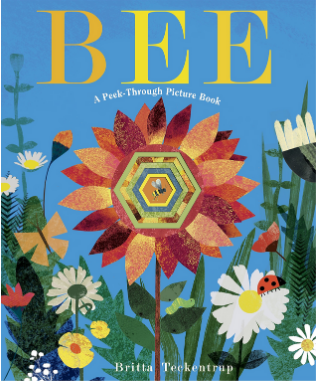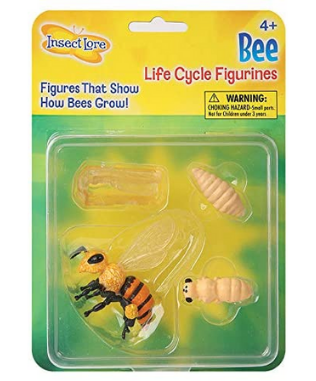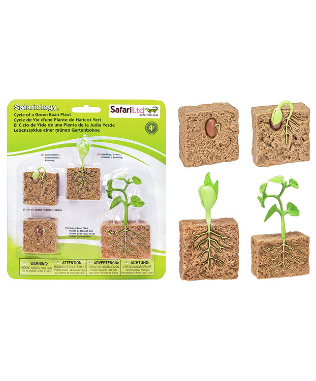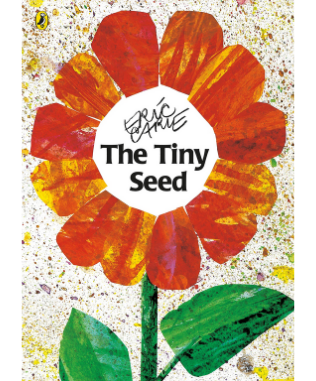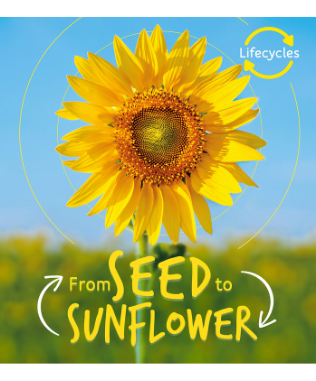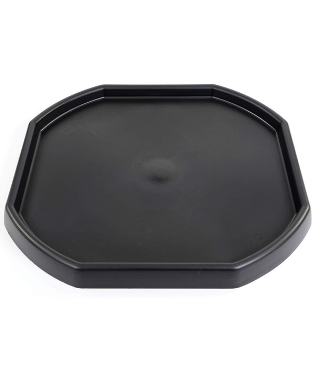After planting our seeds, then repotting them, Ioan decided to set up a tray to teach Finny about the function of different parts of a plant.
Resources
- Bee: A Peek-Through Picture Book by Britta Teckentrup
- The adult bee from our Bee Life Cycle Figurine Set by Insect Lore
- Life cycle of a bean plant models
- The Tiny Seed by Eric Carle
- Lifecycles: Seed to Sunflower by Camilla de la Bedoyere
- A plant weeded out of a pot, while preparing to repot our seedlings
- Sunflower seeds
- Gardening Gloves
Method
When he was happy with his tray, Ioan called us over and explained the set up to Finn.
Finny knew that plants start out as seeds. Ioan knew that seeds come from the flower part of a plant. Some seeds glide, float or spin through the air. Some burst open and fling the seeds far away. Some seeds have little hooks, which help them attach to the fur of animals, travel long distances with them, then drop off. Alternatively, an animal might produce tasty food that a bird or animal might eat, then transport somewhere else (Finn’s favourite).
When you plant seeds, it is important to water the soil, although not too much! This is important because the seeds need to be able to take in oxygen and minerals from the soil and water, through the seed coat’s tiny pores (holes). This gives the inside of the seed the food it needs to break open and make its way through the soil so it can grow into a plant.
The plant is made of three main parts: the roots, the stem and the leaves. Some plants have flowers, which are made up of petals.
The roots hold the plant in the ground and hold it up. They also take in water and nutrients from the soil. The stem holds up the plant and carries water and nutrients to the leaves. Ioan knew from our Unfolding Flower Messages, that this was called capillary action. Plants use capillary action to bring water up the roots and stems to the rest of the plant. The molecules of the water (the liquid) are attracted to the molecules of the inside of the stem (the solid). This attraction is used to help force the water up from the ground and disperse it throughout the plant, even in opposition to external forces like gravity.
The leaves take in the sunshine and turn it into food for the plant, through the process of photosynthesis. Photosynthesis is a chemical reaction that takes place inside a plant, producing food for the plant to survive. Carbon dioxide, water and light are all needed for photosynthesis to take place. The plant uses this food to help it grow.
The flowers look attractive and smell nice to attract bees. Nectar in flowers serves chiefly to attract pollinators, such as fruit-eating bats, hummingbirds, sunbirds, and insects. Nectaries are usually located at the base of the flower stamens, which draw animal visitors into contact with the pollen to be transferred. During plant reproduction, pollen grains need to move from the male anther of one flower to the female stigma of another flower. This is called pollination.






The BBC Bitesize website has a good Key Stage 1 video called, What are the parts of a plant? and a Key Stage 2 video called, Parts of a plant. For information on photosynthesis, there is a Key Stage 3 video called Plants and photosynthesis.









After his nap, Cian (19 months) enjoyed exploring the tray. He loved pointing to everything and getting Ioan to name them.
He played with the bee and the plants, then read the books.
DfES Outcomes for EYFS and National Curriculum (2013)
Science Year 1 programme of study
Plants
- identify and name a variety of common wild and garden plants, including deciduous and evergreen trees
- identify and describe the basic structure of a variety of common flowering plants, including trees.
Science Year 2 programme of study
Plants
- observe and describe how seeds and bulbs grow into mature plants
- find out and describe how plants need water, light and a suitable temperature to grow and stay healthy.




















